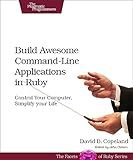Best Command Line Tools to Buy in October 2025

Data Science at the Command Line: Obtain, Scrub, Explore, and Model Data with Unix Power Tools



Powerful Command-Line Applications in Go: Build Fast and Maintainable Tools



Small, Sharp Software Tools: Harness the Combinatoric Power of Command-Line Tools and Utilities



Cleaning Data for Effective Data Science: Doing the other 80% of the work with Python, R, and command-line tools



Command Line Fundamentals: Learn to use the Unix command-line tools and Bash shell scripting



The Linux Command Line: A Complete Introduction



Windows 7 and Vista Guide to Scripting, Automation, and Command Line Tools
- AFFORDABLE PRICING FOR QUALITY READS YOU CAN TRUST.
- SUSTAINABLY SOURCED, PROMOTING ECO-FRIENDLY READING HABITS.
- THOROUGHLY INSPECTED FOR QUALITY, READY FOR YOUR NEXT ADVENTURE.



Build Awesome Command-Line Applications in Ruby: Control Your SPuter, Simplify Your Life
- AFFORDABLE PRICES ON QUALITY USED BOOKS FOR SAVVY SHOPPERS.
- ECO-FRIENDLY CHOICE: REDUCE WASTE BY BUYING USED INSTEAD OF NEW.
- UNIQUE FINDS: DISCOVER RARE TITLES NOT AVAILABLE IN NEW EDITIONS.


To access the command line for XAMPP on Windows, follow these steps:
- Open the XAMPP Control Panel by searching for XAMPP in the Start menu and clicking on it.
- Once the control panel is open, click on the "Shell" button located next to the "Stop" button for Apache and MySQL.
- This will open a command prompt specific to XAMPP, allowing you to run command line operations.
- Alternatively, you can access the command line by opening the Command Prompt or PowerShell on your Windows system.
- Navigate to the XAMPP installation directory using the "cd" command. By default, XAMPP is usually installed in the "C:\xampp" directory.
- Once you are in the XAMPP directory, you can run various command line commands and tools such as MySQL, PHP, and Apache by typing their respective command names.
Note that running commands in the XAMPP command line requires administrative privileges, so make sure to run the Command Prompt or PowerShell as an administrator.
How to create a new database in XAMPP's MySQL?
To create a new database in XAMPP's MySQL, you can follow these steps:
- Ensure that XAMPP is installed and running on your system. Launch the XAMPP Control Panel.
- Start the MySQL database by clicking the "Start" button in the Actions column.
- Open a web browser and go to http://localhost/phpmyadmin/. This will open the phpMyAdmin interface.
- In the phpMyAdmin interface, click on the "New" button located in the left sidebar or the main dashboard.
- Enter a name for the new database in the "Create database" field. Choose a meaningful name that represents the purpose or content of the database.
- Select the appropriate collation for the new database. The collation determines the character set and the rules for sorting and comparing data. You can generally leave this as the default value.
- Click the "Create" button to create the new database.
Once the database is created, it will be listed in the left sidebar of phpMyAdmin. You can now use this database to create and manage tables, as well as perform various database operations.
How to start and stop XAMPP's Tomcat server?
To start and stop XAMPP's Tomcat server, you can follow these steps:
- Open your XAMPP control panel.
- In the control panel's top menu, click on the "Tomcat" button. This will open the Tomcat configuration panel.
- In the Tomcat configuration panel, you will see two buttons at the bottom: "Start" and "Stop". Click on the "Start" button to start the Tomcat server. It may take a few moments for the server to start up.
- Once the server has started, you will see a green indicator next to the Tomcat button in the control panel.
- To stop the server, click on the "Stop" button in the Tomcat configuration panel. The server will be stopped, and the indicator next to the Tomcat button will turn red.
Note: Remember to save your work and shut down any applications using the server before stopping it to avoid data loss.
What is the purpose of XAMPP's Tomcat server?
XAMPP's Tomcat server is used to provide a web server environment for Java-based web applications. It allows you to run Java Servlets and JavaServer Pages (JSP) in addition to supporting other Java technologies such as JavaServer Faces (JSF) and JavaBeans. Tomcat is a popular choice for developers working with Java web applications as it provides a lightweight and easy-to-use server environment. So, the purpose of XAMPP's Tomcat server is to enable the development and deployment of Java-based web applications on the XAMPP platform.
